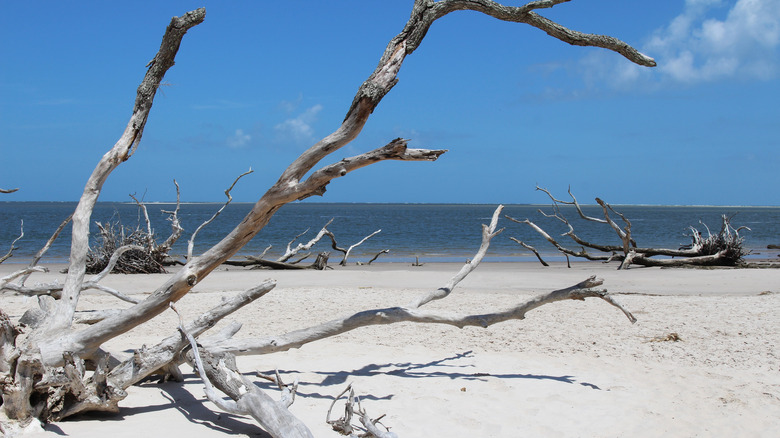Planning a beach-focused getaway that’s fun for the whole family isn’t a hard thing to do when you decide to journey to sunny Florida. Here, inviting stretches of white sand shoreline are the norm and visitors often find themselves longing to return year after year with good reason. While destinations like Cocoa Beach and Miami Beach typically top traveler lists when it comes to waterfront fun, Boneyard Beach is a hidden gem that’s ideal for explorers looking for a more unique place to settle in and spend a day on the sand.
You can find Boneyard Beach sitting within the protected parameters of Big Talbot Island State Park in the heart of Jacksonville. Don’t let the name fool you, though, because this beach is far from scary. Instead, it’s an aesthetically fascinating place where visitors can enjoy incredibly stark contrasts across the landscape. There’s a good chance you haven’t seen anything like this beach before. Here, you’re guaranteed to constantly be reminded of the incredible power of Mother Nature. The scenery at Boneyard Beach is an authentic testament to the ever-fluctuating coastal ecosystems that Florida hosts. It’s also a living example of the resilience nature shows when put to the test of time.
Admire an otherworldly view

When you make your way to Boneyard Beach, you’ll be greeted by three miles of shoreline to explore. The beach runs along the scenic Nassau Sound, and because it sits on federally protected land, there’s not a high-rise in sight. While the tranquility here is palpable, it’s what sits on the sand that tends to inspire. The shoreline at Boneyard Beach is dotted with impressive 30-foot bluffs and enormous driftwood trees that have been scattered by powerful storm waters and winds over time. They’re the very reason behind the beach’s menacing name. As the sun has bleached the driftwood white, they nearly perfectly resemble bones lying across the sand.
Twisted branches and oversized trunks give this beach an almost otherworldly vibe. It’s a destination that captures the imagination and easily makes an amazing backdrop for family photos or landscape photography during a visit. It’s also a clear reminder that nature very much knows what it’s doing. While the driftwood “bones” were deposited by storms, they also work as effective barriers against further erosion. They essentially create an entirely natural protection system designed to keep the shoreline intact for years to come, despite severe weather in the area.
Plan your unforgettable beach visit

To access Boneyard Beach, you’ll make your way to the main entrance of Big Talbot Island State Park which sits off State Road A1A North. It’s just $3 per vehicle to enjoy time here. Boneyard Beach is an easy addition to just about any itinerary, because it’s open to the public from 8 a.m. until sundown, every day of the year.
Once you’ve parked your car, it’s a short hike to reach Boneyard Beach. Look for the Shoreline Access Trail signage and follow the path up and over the hill until you see driftwood towering in the distance. There aren’t any restrooms on-site at Boneyard Beach, so it’s a good idea to prepare for that scenario before you arrive. Once you reach the beach, the driftwood is yours to explore freely. Many visitors spend time climbing the twisted remnants and snapping stunning photos along the way. If you stick around to witness a gorgeous sunset, you’ll be treated to gnarled driftwood shadows cast against a colorful horizon.
Swimming isn’t allowed at Boneyard Beach, which frees up time for activities like birding. Be sure to pack your binoculars for better views of the ospreys, roseate spoonbills, and white pelicans that frequent the area. The wooded trails leading to the beach provide a rich ecosystem for white-tailed deer and raccoons, as well as argiope spiders that are easy to spot thanks to their black and yellow coloration.

